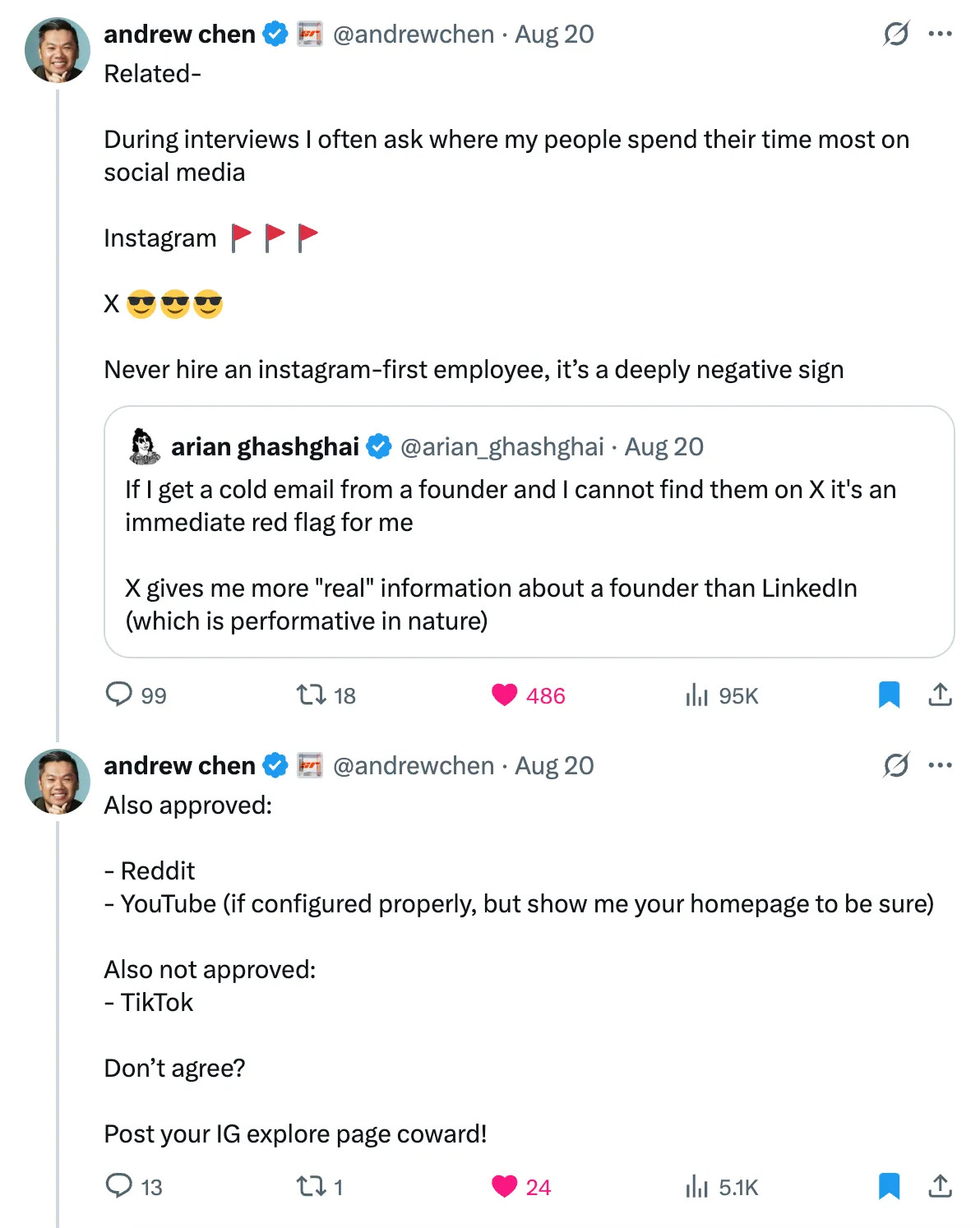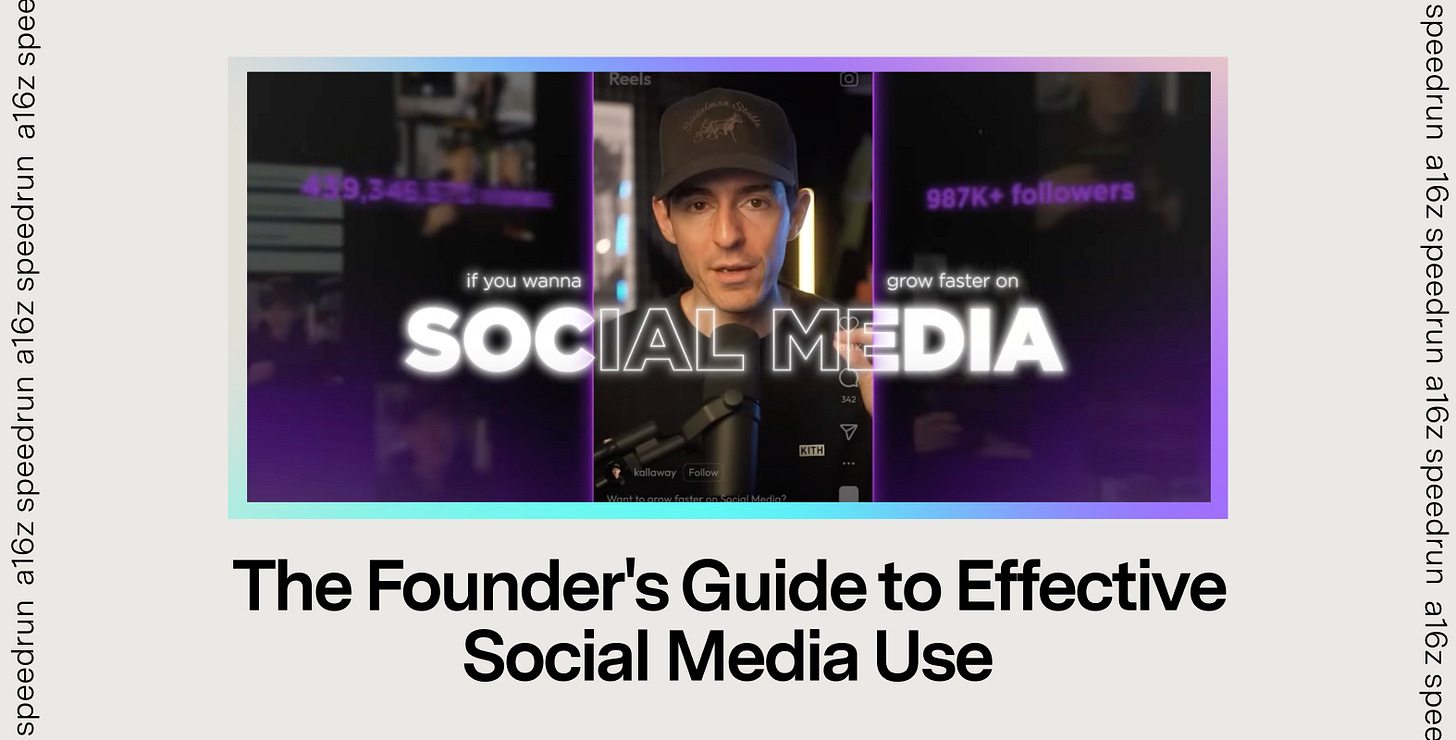The Founder's Guide to Effective Social Media Use
Your next investor is on X. Should you be?
💡 This Week’s Big Ideas
📅 Investors: Host a Tech Week event with us! SF/LA Tech Week hits this October, and we’re backing investor-led events with up to $5K in grants. Want to throw a mixer or gathering? Submit your idea here.
📢 We’re hiring at a16z speedrun! We’re looking for someone to own and expand our global investor ecosystem. See Josh Lu’s post on LinkedIn for details.
🧠 We’re also hiring for a social media manager role. Samira has the deets.
💼 Join our talent network for more opportunities. If we see a fit for you, we'll intro you to relevant founders in the portfolio.
Last week, early-stage investor and founder of Earthling VC Arian Ghashghai offered the following provocation on X:
What if other investors think like Arian? Founders might be forced to ask themselves something terrifying: Should I be spending more time on X?
We decided to follow up with Arian and dig into his thinking. In an email sent to a16z speedrun, he offered an interesting framework for thinking about posting on social as a founder: It makes the process of doing diligence on very early stage companies easier for investors.
I invest pre-seed so I'm referring primarily to pre-seed stage founders who have very little or no data for their company (i.e. they’re really just starting out). This means I've evaluating people more than a company.
The reason I'm getting a cold email is that they found no means of getting a warm intro to me. (This can be a yellow or red flag—e.g. in the case where it's obvious that this was a mass AI-slop email to a bunch investors on a spreadsheet.)
Since I have no trusted pre-vet (i.e. from a warm referral from trusted network), I need to do diligence on said individual or team from publicly available sources to decide whether I'd want to engage further. This is assuming something already compelled me from the substance of the cold email to dig deeper, that's a different topic entirely.
Under those assumptions, X is the most reliable source of diligence.
—Arian Ghashghai
In other words, the original tweet was as much about cold-emailing as it was about social media. If you’re coming to investors via a warm referral, the investor is going to have other ways of finding out information about you, namely talking to mutual contacts.
But in the absence of better methods for doing diligence, Arian says that he sees X as being useful for founders as a channel for building in public. It’s a place where founders can “build a whole canvas of work about who you are, what you believe in, how you think, and ultimately how you're using those insights to build a company,” he argues. “Typically, if I see measurable velocity in what they're working on (and some interesting insights/view points complimentary to whatever they're building), I'd become considerably more inclined to take a meeting from the cold email.”
A few more tips from Arian for founders building on social:
1) Post regularly. Success on socials is marathon not a sprint, and it may take a while to see "results". But just keep doing it. I think a lot of founders starting out on X think they need to be a one-hit wonder.
2) Re-post your launch until it works. No one will remember what you posted two weeks ago if it didn't go viral, so you can launch your product multiple times.
3) Be proactive and DM people you find interesting. Also ask why your own profile matters. People will look at what you post and who follows you. This is the lowest hanging fruit to expand your network into areas you would not have thought possible.
4) Particularly when starting out, understand what your niche is (I’m not that good at this). It's easier for founders, given companies are focused in specific areas, but understand what people are following you for and double down until you grow to a certain size. For me, this was tweeting about the VR industry.
—Arian Ghashghai
How (and Where) to Build on Social w/ Kane Kallaway
That being said… how do others think about social media usage?
a16z GP Andrew Chen QTed Arian’s post with his own take:

This was “a bit of a troll post,” Andrew said in a followup DM. But there’s some truth to it, as well. For founders building early-stage startups, some social networks offer more value and signal than others. So how do you put together a content strategy for any given social network?
We decided to ask a professional.
Content creator and Sandcastles.ai founder Kane Kallaway is unusually good at earning reach across many social media channels, with 340k followers on Instagram, 225k on YouTube, and 360k on TikTok. These days, one of Kallaway’s main subjects is how founders can unlock online distribution by using social media more effectively.
We decided to pick Kallaway’s brain with a few more questions about social strategy for founders:
A16Z SPEEDRUN: You've spoken about the strategy behind picking the right platform based on your target audience. What are the right strategies for reaching early stage investors specifically?
KANE KALLAWAY: Early stage investors live X, LinkedIn, YouTube. Many of them passively scroll IG/Tiktok, but their primary content time is the first three. I'd go all-in on building the strategy inside out for each of those. Now for each, there is a slightly different strategy that is optimal:
For X, it's just hammering the short-form text tweets like many of them like to do, adding in images/videos in the cards. The key is saying non-obvious things that are either extremely helpful and/or controversial. And doing this 5-10x per day consistently. Founders all know this, but are probably not doing enough volume and/or framing things in an interesting enough way. The key with X and LinkedIn is to be early and often to comment on industry adjacent tweets also with non-obvious interesting things. This is the barnacle on whale strategy. The right people will see this stuff over time
For LinkedIn, the combination of text posts and text + short-form video posts are crushing. For text posts, I'd just repost what you're using on X (ideally with at least a static image card that complements it). The real bread and butter right now is short-form video with complementary (not script repeating) text. There is a full rabbit hole here with respect to what works with short-form on linkedin, but again, non obvious useful takes or breakdowns is best
For YouTube, you've got two plays...either dedicated mid-form videos (10-15 minutes) that are breaking down on-target topics that early stage investors care about, or it's the long-form podcast playbook. Long-form pods for this audience feel saturated but there's shockingly not that many that are actually good. I'd be taking the clips from those podcasts and building a clip army to post on IG/Tiktok/LinkedIn. Full strategy to be explained here. Not hard to execute. The hard part is getting people on the pod that are actually interesting.
Any other tips for other founders here?
Yes. When it comes to launch videos, I recommend all companies do two types:
A controversial cinematic: Like what Cluely or Friend does (going for X virality)
Product sizzle/walkthrough: heavy color/contrast/motion (designed for creators to use as b-roll in their videos)
A few others:
Broadly, if every company is not thinking organic video first, and/or doesn't have someone running marketing that has a following or has made winning content, they should prioritize solving that immediately.
Every founder should be building both an inside-out content strategy and an outside-in one to run in conjunction. Inside out is having a Content Scientist running a full R&D playbook to figure out what ideas/formats work for their business. Once one works, you create a new channel and scale with a content pod. I talk about how to do this here.
Get someone on the team to be a Creator PR role. This means finding all of the top creators in your space (IG/Tiktok/YouTube/LinkedIn/X), building relationships with them, tipping them off about new releases, and building a dropbox folder full of video assets for them. If you invite these creators to early access, half of them will make content for you for free. This is the free distro hack that most companies don't do. Will caveat, the product has to actually be good for this to work. Most are not.
If your content isn't working, you haven't done enough volume.
That’s it for this week! For more weekly dives into the cutting edge of tech, entertainment, and AI, subscribe to our newsletter below.







Andrew's LI post was so troll but I see his point now!
how can I register
I have been on your tail sharing my Idea on your X handle 💡
I am the co founder of S M I D in an app that have not been created yet